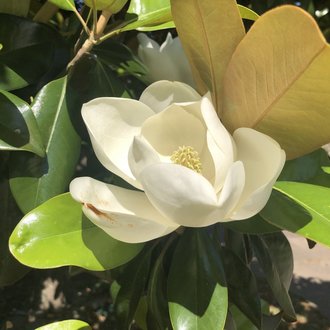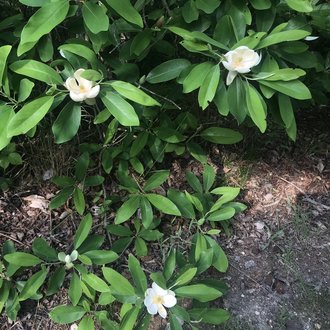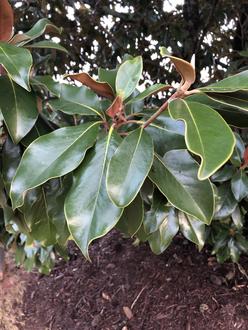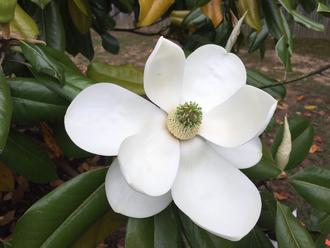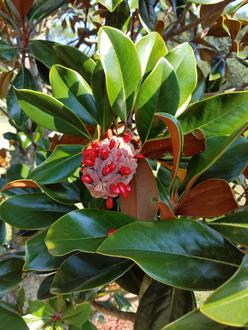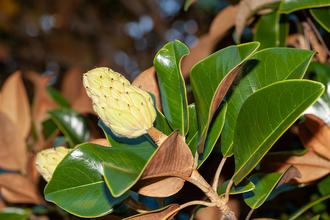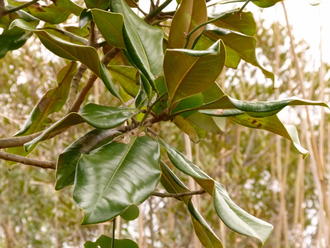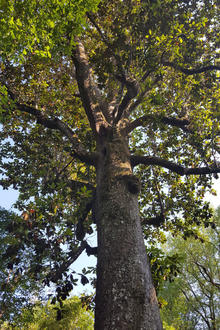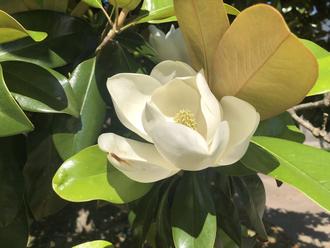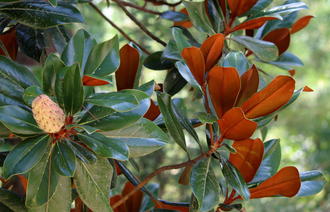Southern Magnolia (Magnolia grandiflora L.)
↑Summary
A native broadleaf evergreen tree of moist, well-drained sites in the deep south, with large, showy white flowers.
↑Range - Expand
| Legend | Color |
| Expanded or Not Present | |
| Native or Expanded | |
| Native | |
| Native or Not Present | |
| Expanded | |
| Native or Expanded or Not Present |
This map is based on our research. We have checked its accuracy to Level 3 ecoregions. Although this plant occurs somewhere in each of these regions, it may only occur in a small part of some or all of them.
This species is widely cultivated, and readily seeds into the wild. Its expansion is limited by its poor cold tolerance. A combination of global warming and the breeding of cold-tolerant cultivars has led this species to expand northward. It will likely continue to expand as the climate warms, although the irregularity of climate change may mitigate this somewhat as a single cold winter can be sufficient to kill young trees.
↑Similar Plants
↑Habitat
Found in hardwood forests in the south, associated with both evergreen and deciduous species. Habitats include well-drained sites in bottomland woods and woodlands in coastal areas, swamp margins, and mesic upland sites protected from fire.
Prefers rich, loamy, moist soils. Although it grows mostly in bottomlands, it requires well-drained sites and is intolerant of flooding. Tolerant of salt spray and some soil salinity, and thus able to grow in coastal areas very close to the ocean, although in much of its range the areas closest to the ocean have too drought-prone, sandy soils.
Moderately shade tolerant, especially when young, and able to establish underneath pines or hardwoods that produce a more open canopy. Cannot reproduce under its own shade, but able to persist in forests indefinitely through colonizing gaps, and considered part of the climax community on most of the site where it is found.
Its range is expanding northward, aided by a combination of global warming and widespread planting in landscaping; although historically it was limited to East Texas through South Carolina with a few scattered populations in North Carolina, it has now estalished sustaining wild populations in Arkansas, Tennessee, far western Kentucky, West Virginia, Virginia, and Maryland. It is still scattered and uncommon in these areas.
↑Life Cycle
Southern magnolia is a rapidly-growing, but shade-tolerant broadleaf evergreen tree.
Seedlings quickly estalish a taproot and grow rapidly, as much as 2 feet a year in optimal, sunny conditions, but may be much slower under a closed forest canopy. Seedlings are highly susceptible to frost and will be killed by even a light frost. Even once established, seedlings are also more cold-sensitive in their first few winters. Young trees may persist for 10-20 years in the understory, growing little in heavy shade, but growing rapidly in response to the creation of a gap.
Trees may produce seed as early as 10 years of age, but seed production is usually low until 25 years of age. About half of the seeds are viable; seeds are primarily distributed by birds and other mammals.
Seeds often germinate in the first fall following distribution, but some remain dormant and germinate the second year. We could not verify how long this species persists in the seed bank, but other related plants often have some seed, albeit a low percentage, remain viable for up to 7-8 years, so it is possible that this species forms such a seed bank. Germination is best in moist, nutrient-rich soil with ample leaf litter. Seed germination is inhibited under mature trees of this species.
Trees also reproduce vegetatively, sending up new shoots from lateral roots to take advantage of gaps.
Trees usually live 80-120 years. Mortality occurs from a variety of causes, including fire and winter drought. Stressed trees often are heavily attacked by the magnolia scale (Neolecanium cornuparyum) insect, which can kill branches or entire trees.
↑Faunal Associations
Various mammals, including squirrels and oppossums, and birds, including quail and wild turkey, eat the fruit. Some birds that do not normally prefer fruit, such as the introduced common starling (Sturnus vulgaris) will eat the fruit of this species due to its high fat content.
Numerous insects eat this species. Of these, only the magnolia scale (Neolecanium cornuparyum) causes significant damage. Other insects supported by this tree include the oleander pit scale (Asterolecanium pustulans), tuliptree scale (Toumeyella liriodendri), tuliptree aphid (Illinoia liriodendri), striped mealybug (Ferrisia virgata), Yellow-poplar weevil (Odontopus calceatus), magnolia leafminer moth (Phyllocnistis magnoliella), the spider mite (Tetranychus magnoliae). The larvae of the magnolia root borer (Euzophera magnolialis) also eats the root of this species; it causes significant mortality of nursery-grown plants but does not cause serious harm to this species in the wild. Most of these species also eat other magnolias and often tuliptree (Liriodendron tulipifera) as well, and for many of them southern magnolia is not their preferred host.
↑Uses
Widely planted as a landscaping plant, including quite far north of its native range. Valued for its large, showy flowers, with a long blooming period, as well as the bright red berries, and distinctive evergreen foliage. Numerous cultivars exist, including ones specifically selected for cold-hardiness.
When planted in cold regions, frequently succumbs to cold winters, especially in prolonged periods of windy weather during periods of winter when the ground remains frozen, as the tree cannot replace its stores of water lost from wind. The hard wood and growth habit with a rounded crown also makes it particularly susceptible to damage from snow and ice.
Used for timber in the south, where it is usually lumped together with other Magnolia species and sold generically as magnolia wood.
Extracts from the leaves, fruits, bark, and wood have been explored for potential pharmaceutical uses.
↑Related Plants
A number of other Magnolia species, both native and introduced, occur in North America, mostly also in the southeast and overlapping to varying degrees with this one in range. This species has been artificially hybridized with sweetbay magnolia (Magnolia virginiana), as well as with Magnolia guatemalensis, but no known natural hybrids have ever been reported.
↑Links & External Resources
• Southern Magnolia | The Wood Database (About This Site)
• Southern Magnolia | Fire Effects Information System (FEIS) (About This Site)
• Magnolia grandiflora (Southern Magnolia) | USDA PLANTS Database (About This Site)
• Southern Magnolia | iNaturalist (About This Site)
• Magnolia grandiflora (Southern Magnolia) | Missouri Botanical Garden Plant Finder (About This Site)
• Southern Magnolia | Virginia Tech Dendrology Factsheets (About This Site)
• Southern Magnolia | Silvics of North America (About This Site)
• Magnolia grandiflora | Biota of North America Project (BONAP) (About This Site)
• Magnolia grandiflora | NatureServe Explorer (About This Site)
• Magnolia grandiflora | Flora of North America (About This Site)
• Southern Magnolia | Maryland Biodiversity Project (About This Site)
• Magnolia grandiflora L. (Southern Magnolia, Bull-bay) | Digital Atlas of the Virginia Flora (About This Site)



